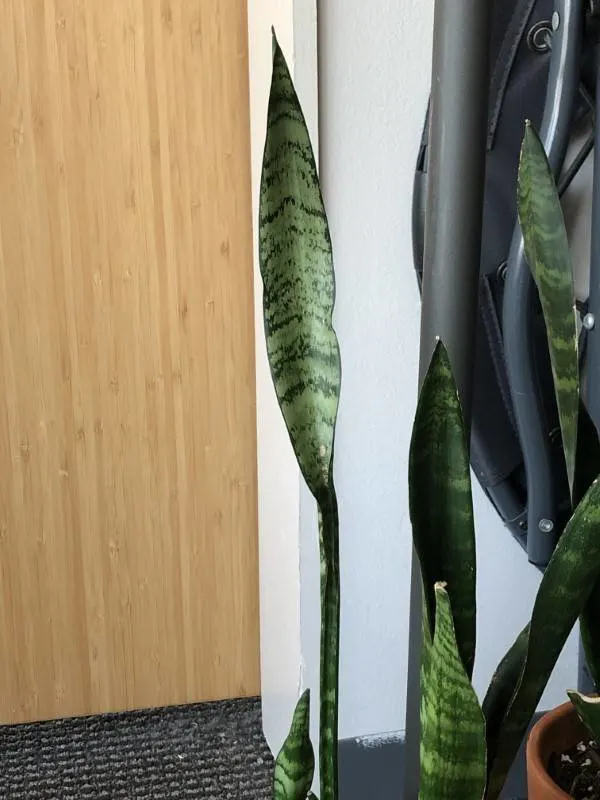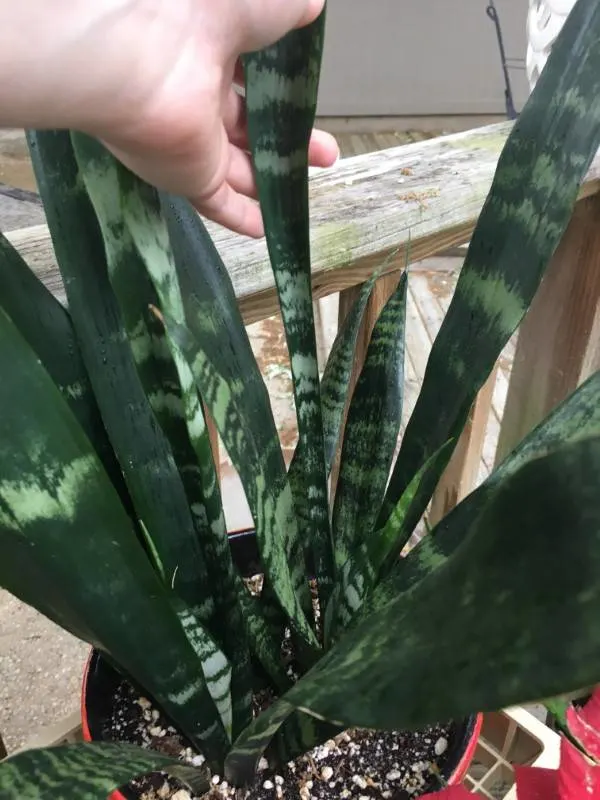Snake plants are at the top of the list for home décor enthusiasts who prefer a natural interior with many indoor plants lining the walls. These plants are a great addition to your home as they come with several benefits.
Snake plants can clean up the air in your home as they convert CO2 into oxygen, thereby purifying the environment. They remove pollutants from the air, improve the outlook of your home, help in boosting mental health, and are low maintenance.
However, you may see that your snake plants have grown to be too narrow and skinny. This can leave you worried and plagued with the question – why are my snake plant leaves skinny?
If you have been facing this issue, don’t worry, as this guide will explore all the reasons behind your question – “why are my snake plant leaves skinny” and what to do to make your house plants better. Let’s begin!

5 Causes Of Why Your Snake Plant Leaves Are Skinny- And What To Do About them?
There are several reasons why your snake plants might turn out skinny. It is mostly due to environmental reasons or not getting the required balance of prerequisites.
If your snake plants do not receive enough light, are not given enough water, are underwater, or undergo temperature change due to transplantation, the shock can render them unable to develop fully and hence, narrow in outlook.
You must ensure to provide all the necessary conditions. To do that, you should know the reasons that can leave your plant underdeveloped. Keep reading to explore all the possible causes for your question why are my snake plant leaves skinny?
1. Not Enough Sunlight
Whenever the question Why Are My Snake Plant Leaves Skinny pops in your head. The first factor to look out for is the amount of sunlight it receives.
If it does not receive the optimum amount of sunlight, the snake plant will lengthen and stretch its leaves to reach the sunlight’s source. This will cause its leaves to become skinnier. The snake plant will not wilt, but it will undoubtedly become less aesthetic to look at.
Many garden enthusiasts, especially those who care for indoor plants, forget that plants have hundreds of photosensory receptors to detect the presence of sunlight. While it is true that snake plants fall into low-light plants, it does not mean that you can shun them to shadowy areas.
What to Do About It?
Sunlight is a necessity for plants plays, and it plays a vital role in their development. You can boost the growth of your indoor plants exponentially by making sure they receive an adequate amount.
If you find your snake plant leaves becoming narrow, they are searching for sunlight. The immediate solution is to move them to a room where they get bright indirect sunlight or moderate direct sunlight.
During late Autumn, cut off its skinnier leaves, and your beloved plant will grow out thicker and with fuller leaves in no time.
2. Overcrowding the Pot with Too Many Snake Plants
Since the snake plants cannot survive in the outdoors environment, you are left with no choice but to care for them in your home. To save up on space, you may plant numerous snake plants in a single pot.
This huddling of too many plants can create competition between them for the available resources. Moreover, your snake plants may outgrow the space available in a single pot. The crowded space and lack of resources cause your snake plant leaves to narrow down and become skinny so they can save both space and resources.
What to Do About It?
If you do not move the plants to separate pots immediately, your snake plants will have slender leaves. Move your snake plant to another pot and use a fresh batch of soil for each one. It ensures that your plant has the necessary nutrients to aid and boost its growth.
Also, keep rotating the pot so all the leaves can get enough sunlight instead of just the ones in the front.

3. Inadequate Fertilization
The indoor snake plants share many similarities with their outdoor friends. One of them is their liking of fertilizer. Snake plant experts’ go-to answer to “Why Are My Snake Plant Leaves Skinny” is to examine the fertilizer’s contents.
Indoor plants need just as many nutrients as outdoor plants. If the soil lacks the correct balance of nutrients, your snake plants will show stunted growth and narrow leaves. It may even start to turn yellow after a while.
What to Do About It?
Look into fertilizers with a higher percentage of nitrogen, potassium, and phosphorus. These will aid the plant’s growth and ensure that the leaves are thicker, wider, and fuller.
- 28-0-0 Lawn Food: 70% Quick Release and 30% Slow Release Nitrogen: Quick Release Nitrogen for immediate nutrients, and Slow Release Nitrogen to continue to feed in between fertilizer applications.
- Lawn Energizer Booster: Encourages Darker Green Turf: Lawn Energizer contains Nitrogen and Iron to help you achieve that dark green color.
- Easy to Use: Our Lawn Fertilizers come with a ready-to-use hose end sprayer that applies the perfect ratio of product for lawn applications. Covers 3,200 square feet.
If heavy damage has been done, you may need to re-plant it into a new pot. Make sure to get fresh soil and fertilize it well before putting the snake plant in. Add water and keep it in bright sunlight. You can cut off the skinny leaves to allow fresh foliage to grow.
4. Inadequate Water
The correct amount of water is essential for the plants to grow in their right shape. People tend to procrastinate indoor watering plants. This underwatering can cause the plants to shrink and grow skinny leaves. Giving too much water can have a similar effect as the plant won’t be able to take up nutrients from the waterlogged soil.
What to Do About It?
Consider your snake plant’s immediate environment before working out a watering schedule. Typically, a snake plant requires water every seven to ten days. If the climate is too humid, you can extend the timeline up to fifteen days.
You should ensure that the plant is being watered regularly in hotter climates. You can touch the soil for checking the moisture or use a moisture meter when in doubt and if it is too dry, and then provide the plant with water immediately.
- HUMIDITY SENSOR: Our handy meter tool can quickly determine what level of remediation is needed to keep your family safe from black mold. High levels of dampness that go untreated are the leading cause of harmful fungus growth in the home.
- WATER LEAK DETECTOR: Finding the moisture content in your wood or drywall is the first step in early prevention. Continuously check and test suspicious water stains around the house so you can determine whether the area is wet or has already dried. Low, medium and high moisture tones and on-screen icons, Reading HOLD button
- MOISTURE READER: The mold test features large 0.3" high digits in a backlit LCD for quick and easy detecting. Our mildew scanner includes extra 8mm stainless steel pins, a protective cap that doubles as a calibration checker, and a “9V” battery.
- MOLD TESTER: For an accurate test read, stick the stainless steel pins into the surface of what you're measuring. The gauge has a broad range of 5 - 50% for wood and 1.5 - 33% for building materials such as concrete and drywall.
- GENERAL TOOLS: We're a recognized leader in designing and developing specialized precision tools dedicated to delivering exceptional customer service. We encourage artisans and DIYers to work smarter, measure better, and repair more productively.
5. Transplantation
As plants grow, you will have to transplant them into new pots with fresh soil. This can prevent several issues like lack of space, overcrowding, lack of resources, etc. Letting plants grow in the same pot and soil can be the reason for the skinny snake plant leaves.
What to Do About It?
After a few weeks, you should transplant your new snake plant pups into another pot with a fresh batch of fertilized soil. New snake plant pups require a ton of energy. Make sure you keep them well fertilized and watered with adequate sunlight. They will be growing thicker leaves in no time.
Conclusion
Whenever you encounter the question “Why Are My Snake Plant Leaves Skinny,” Remember that slender leaves do not present any immediate danger to the plant. However, the solution will take a couple of days and even weeks before the plant shifts back to its growth model.
Now that you can understand the problem, hopefully, the next time you come across this question, you will be able to counter the problem immediately. If you have any unique experiences with your snake plant, don’t for get to share them with us.


